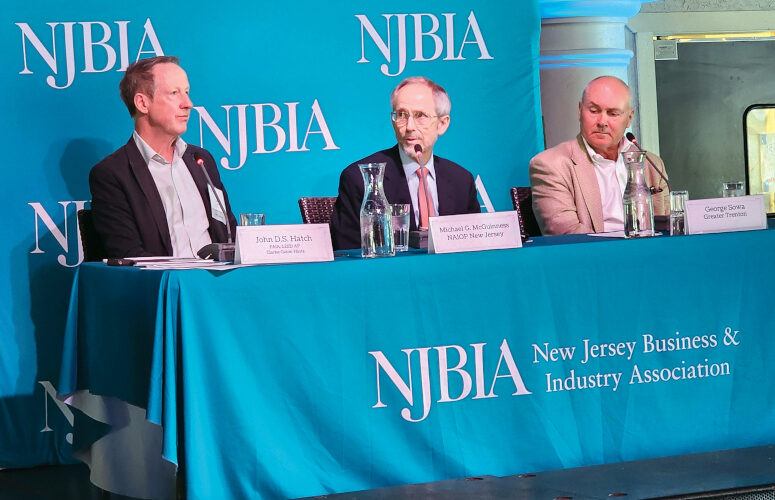
No Time to Lie Dormant Regarding State’s Stranded Assets Problem
By Anthony Birritteri, Editor-in-Chief On May 11, 2023Stranded assets, abandoned properties in both urban and suburban settings, dot New Jersey’s landscape, negatively impacting the municipalities in which they are located both from a tax ratable and a visual blight aspect. Yesterday, at an event hosted by the New Jersey Business & Industry Association and Greater Trenton, six experts from state and local government, as well as private industry, gathered to discuss the challenges and opportunities of redeveloping these dormant properties.
Appropriately, the event was held at Cooper’s Riverview in Trenton, the site of the former Trenton Iron Works, a factory built in 1847 that has been transformed, over the past few decades, into what is now a restaurant, nightclub and meeting place.
Trenton was also the ideal location for the event because the municipality has some 2,000 properties (mostly stranded) that it is trying to find new purposes for, according to Willard Alonzo Stanback, acting director, Department of Housing and Economic Development for the City of Trenton.
There is a great demand for new housing in the city, but Stanback explained that there has to be balance between turning stranded assets into housing vs commercial businesses. “Retail follows rooftops, but we have to be mindful of not having too much of a ‘chicken or the egg’ scenario,” he said. “We have to be thoughtful about the amenities, businesses and other types of things that come with those residents, so that we are not just building businesses that make no sense for the population we have.”
Daniel E. Jennings, executive vice president, real estate development & programs, New Jersey Economic Development Authority (NJEDA), said that the authority recognized that stranded assets were going to be a growing problem in the state.
“This is a problem that neither the private sector, the property owner, the municipality or county government can solve [on their own],” Jennings said.
He outlined various existing NJEDA programs that are available to help develop stranded assets, including the Aspire, Brownfields Redevelopment Incentive, and the Historic Property Reinvestment programs.
However, the big announcement of the morning was the NJEDA’s move to create a new investment policy for the redevelopment of stranded assets. Through the creation of a $25 million Stranded Assets Repositioning Investment, the NJEDA will consider investment opportunities through unsolicited proposals from redevelopers. According to an NJEDA press release issued this morning, proposals will be evaluated equitably based on several factors, including developer qualifications, operational readiness, economic feasibility, and developer engagement with the local community.
“The guidelines are pretty flexible, and we can make investments anywhere around the state,” Jennings said, adding, “This is in recognition that repositioning stranded assets is an expensive proposition. … We know that one sector cannot tackle this alone.”
Meanwhile, Matthew Kertz, a partner and real estate attorney at Genova Burns LLC – who often represents landowners and redevelopers seeking to repurpose stranded assets – said that deals can fall through at times due to the local community not agreeing with a developer’s plans. He lists historical site reasons as one example.
Overall, Kertz said that from a redeveloper- and property-owner perspective, the secret to redevelopment success is their willingness to engage with the community; showing it how the project will deliver something vibrant. “You have to show the benefits and be willing to listen to the public,” he said.
It seems like those conversations are being made and are successful.
According to Michael G. McGuinness, CEO of NAIOP New Jersey, the statewide chapter of the national commercial real estate development association, the development of stranded assets is being more commonly explored today when it comes to overall real estate development.
“We have so many vacant retail buildings and offices throughout the state … and more developers are tackling the issue,” he said, adding that in the past two years, more than 6 million square feet of office space in New Jersey has been converted into multi-family housing. This is followed by the conversion of office space into industrial.
The type of stranded asset conversion also depends on the bones of the existing structure.
“An existing building has a particular footprint … a particular column grid. So, not every existing [structure] will be useful for every kind of new use,” said John Hatch, FAIA, LEED AP, partner, at Trenton-based architectural firm Clarke Caton Hintz. “Though reusing a building is typically less expensive than new construction, you have to find the right match.”
Clark Caton Hintz has been finding the right match for a number of projects in Trenton, as displayed by Hatch’s slide presentation. For one building in block 3 of the Roebling Complex in Trenton, the firm designed the conversion of an industrial facility into one- and two-bedroom apartments, with every unit having a loft. On another Roebling block, Clark Canton Hintz designed plans to convert a dormant building into an office complex, with the top floor being used by environmental engineering firm Princeton Hydro as its new headquarters. Meanwhile, another Roebling building is being marketed for pharmaceutical research space.
Hatch also discussed the environmental and sustainability benefits of adaptive reuse, saying, “One of the mantras of the historic preservation community is that ‘a green building is the one that has been already built.’ What this means is that existing buildings already have embodied carbon and energy, and if you could reuse it, it is much more sustainable that even the most sustainable building you can build on a greenfield.”
With these green and possible money-savings benefits, George Sowa, CEO of Greater Trenton, a nonprofit agency whose mission is to advance economic revitalization efforts in the city, is trying to get investors and developers, as well as residents, interested in Trenton.
There is strong demand for residential housing, according to Sowa. A recent Greater Trenton study found that this market need can support 1,270 new residential units, including 995 rental apartments, 200 for-sale rowhouses/townhouses, and 75 for-sale condominiums over the next five years.
“At the end of the day, how do we match the demand with the supply?” he asked. “It’s about trying to generate interest and investment. We are working with the city, the county, the state, and the private sector to make sure every knows Trenton is open for business.”
To access more business news, visit NJB News Now.
Related Articles:





